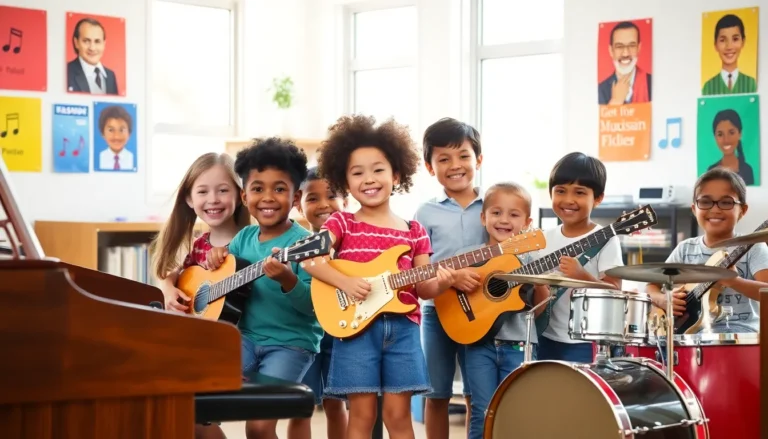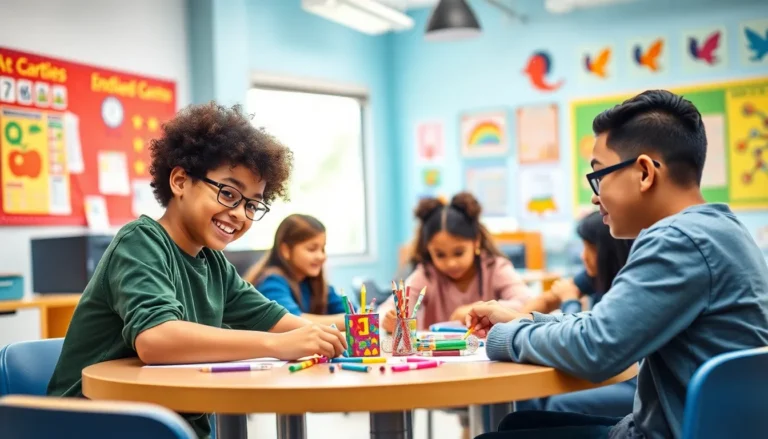In a world where emojis often replace words and autocorrect has a mind of its own, literacy resources are more essential than ever. They’re like a trusty sidekick in the quest for knowledge, helping readers of all ages unlock the magic of language. Whether it’s mastering the art of the written word or simply deciphering that cryptic text from a friend, having the right tools can make all the difference.
Imagine trying to navigate a treasure map without a compass—frustrating, right? That’s what it feels like for many when they lack access to effective literacy resources. From interactive apps to engaging books, these tools not only enhance reading skills but also make learning fun. So, grab your favorite beverage, settle in, and let’s explore the treasure trove of literacy resources that can transform reading from a chore into an adventure.
Table of Contents
ToggleOverview of Literacy Resources
Literacy resources play a crucial role in developing reading and writing skills. These tools support individuals at various stages of their literacy journey. Interactive apps, for instance, engage learners with dynamic content that adapts to skill levels. Educational books provide structured learning experiences through immersive narratives.
Technology also amplifies access to literacy resources. Websites offer free downloadable worksheets and videos, catering to diverse learning styles. Workshops encourage community engagement, promoting collaborative learning among peers.
Gamified learning experiences keep readers motivated and excited. Games designed for literacy often reinforce vocabulary and comprehension in an entertaining format. Visual aids enhance understanding and retention, making concepts clearer for learners.
Tutoring programs provide personalized guidance tailored to individual needs. These programs often implement evidence-based strategies that lead to measurable literacy improvements. Community organizations frequently host events that showcase available resources, fostering collective awareness.
Parents benefit from resources designed to enhance reading at home. Reading lists and activity suggestions empower families to create environmentally rich experiences. By integrating storytelling with daily activities, literacy becomes a regular part of life.
Overall, embracing a variety of literacy resources makes learning enjoyable and effective. Unique offerings like podcasts and online courses enrich the literacy landscape, ensuring accessibility for all. These comprehensive tools not only build skills but also promote a culture of reading that lasts a lifetime.
Types of Literacy Resources

Numerous literacy resources exist to support readers of all ages. Each resource type contributes significantly to effective learning.
Printed Materials
Books represent a fundamental tool in literacy development. Diverse genres, including fiction, non-fiction, and educational texts, nurture vocabulary and comprehension. Graphic novels often engage reluctant readers, while children’s picture books introduce early concepts through visuals. Workbooks complement these materials by offering structured activities that reinforce skills. They also include assessment exercises to track progress. Libraries frequently offer access to a wide range of printed resources, providing community members with free literacy materials.
Digital Resources
Interactive apps transform traditional learning approaches. These apps engage users with adaptive content tailored to individual needs. Online platforms deliver e-books and audiobooks, catering to various literacy levels and interests. Websites that compile free educational resources enhance accessibility, making learning flexible and enjoyable. Video tutorials offer guidance on specific literacy skills, complementing independent study. Gamification elements often motivate learners, making the practice enjoyable and impactful.
Community-Based Programs
Local organizations frequently provide literacy initiatives that foster engagement. Workshops and classes target specific literacy needs, serving both adults and children. Book clubs often encourage reading among peers, creating a shared learning experience. Additionally, mentoring programs pair experienced readers with those seeking assistance, fostering a supportive environment. Community events, such as literacy fairs, highlight the importance of reading and offer resources to families. Such initiatives strengthen community bonds while promoting a culture centered on literacy.
Importance of Literacy Resources
Literacy resources play a vital role in shaping effective communication skills across all ages. These tools not only engage learners but also bolster reading and writing capabilities.
Impact on Learning
Literacy resources significantly enhance the learning process. Effective tools engage students through interactive content, making concepts more comprehensible. Interactive apps, for instance, captivate young readers with games that reinforce vocabulary. Structured educational books provide a clear path for mastering foundational skills. Research supports that students who use diverse literacy resources demonstrate improved reading comprehension and retention rates. Access to online platforms allows learners to explore materials at their own pace, catering to individual learning styles. Additionally, gamification of learning experiences maintains motivation, transforming lessons into enjoyable tasks.
Support for Educators
Educators greatly benefit from the integration of literacy resources in their classrooms. These tools serve as valuable aids in lesson planning and curriculum development. Printed materials, like workbooks and diverse texts, help teachers implement effective reading strategies. Digital resources streamline access to an array of instructional content, allowing for differentiated instruction. Professional development workshops equip educators with innovative techniques to incorporate these resources effectively. Collaboration with community programs also enriches the learning environment, providing additional support for students. Altogether, comprehensive literacy resources empower educators to foster a responsive and engaging educational experience.
How to Access Literacy Resources
Access to literacy resources represents a crucial avenue for enhancing reading and writing skills. Various options allow learners to tap into valuable tools and support.
Online Platforms
Numerous online platforms provide interactive learning experiences. Websites like Khan Academy and Starfall offer engaging educational content tailored for different age groups. These platforms feature a range of activities that promote reading comprehension and vocabulary development. A significant number of free worksheets, videos, and games enhance understanding while keeping learners motivated. Personalized learning paths adapt to individual needs, allowing users to progress at their own pace. Online communities, such as forums and discussion groups, foster collaboration among learners and educators, enriching the learning process.
Local Libraries and Centers
Local libraries and community centers serve as vital resources for literacy support. Many libraries offer free access to diverse books and workbooks that cater to varying reading levels. Programs like storytime sessions and book clubs encourage interactive engagement, fostering a love for reading among participants. Community centers frequently host workshops that provide literacy skills training for both children and adults. They often collaborate with local organizations to enhance outreach initiatives, making resources accessible to those in need. These spaces promote a supportive environment, empowering individuals and families to develop literacy skills together.
Future of Literacy Resources
Anticipating advancements in literacy resources reveals promising trends. Emerging technologies will continue to reshape how individuals access and interact with literacy materials. Innovative tools, such as artificial intelligence and machine learning, will personalize learning experiences, tailoring content to meet specific learner needs.
Interactive platforms are likely to gain popularity, promoting collaborative learning. Virtual reality could transport learners into immersive environments that enhance comprehension and engagement. Students may navigate complex texts while developing critical thinking skills.
Printed resources will maintain relevance, offering tactile experiences that digital formats cannot replicate. Libraries will evolve, incorporating technology while providing a sanctuary for traditional reading. Dedicated spaces for storytelling and workshops will foster community engagement.
Gamification strategies will remain prominent, ensuring learning remains engaging and fun. Students often achieve higher retention rates when content is delivered in playful formats. Progress tracking features will motivate learners, offering immediate feedback on their advancements.
Educators will increasingly leverage these resources to enrich curriculum design and lesson planning. Professional development opportunities will focus on integrating technology seamlessly into literacy instruction. Collaboration with local programs may enhance community support, creating a network that reinforces learning.
Access remains crucial to literacy initiatives. Online platforms will expand, showcasing a variety of interactive content. Successfully bridging the gap between technology and traditional methods will empower families to embrace literacy in daily life.
Communities may unite to advocate for literacy resources that address diverse needs. Accessibility will lead to increased engagement, ensuring that all individuals share the advantages of effective literacy education.
Literacy resources are essential for fostering a love of reading and writing. By integrating printed materials digital tools and community programs individuals can enhance their literacy skills in engaging ways. The variety of available resources ensures that everyone can find something that suits their learning style and needs.
As technology continues to evolve the future of literacy resources looks promising. Innovations will likely offer even more personalized and interactive experiences making learning accessible and enjoyable for all. Embracing these resources not only empowers learners but also strengthens communities by promoting a culture of literacy that lasts a lifetime.





